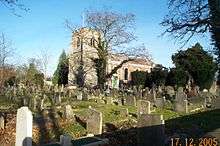St Lawrence's church, Whitchurch
| St Lawrence's, Whitchurch | |
|---|---|
 St Lawrence's in 2005 | |
| Location | Whitchurch Lane |
| Country | United Kingdom |
| Denomination | Church of England |
| Website | http://www.little-stanmore.org/ |
| Architecture | |
| Style | Baroque |
| Years built | reconstructed 1716 |
| Administration | |
| Diocese | London |
| Province | Canterbury |
| Clergy | |
| Archbishop | Justin Welby |
| Rector | Fr Paul Michael Reece |
St. Lawrence, Whitchurch, is a Church of England parish church in Little Stanmore in the London Borough of Harrow, England. The building is Grade I listed.[1] It retains a stone tower dating from ca. 1360, but the main body of the building was constructed in the eighteenth century in Baroque style.
History
The original medieval church was reconstructed by the architect John James, working for a wealthy client James Brydges. Brydges, who was later 1st Duke of Chandos, started rebuilding the church and Cannons, his nearby country house, around the time he succeeded his father as ninth Baron Chandos in 1714. Brydges had a habit of changing his architect and in 1715 John James was replaced as architect for the house by James Gibbs, who may have been involved in the completion of the church prior to its reopening in 1716.
Brydges later constructed a private chapel in the house, but he continued to take a personal interest in the church, where he had a gallery for the use of himself and his entourage.[1] He had the right to nominate the minister, and chose John Theophilus Desaguliers FRS, who also served him as chaplain and engineering consultant.
Description
The highly decorated interior of the church is unusual in England, Continental Baroque rather than English Baroque in style.
Decoration
The decorative painter Louis Laguerre and other painters worked on both the church and the house.[2]
The Chandos Mausoleum
Towards the end of his life Brydges had lost much of his wealth, but in 1735 he had a mausoleum, designed by Gibbs, built next to the church.[3] Burials here include the 1st Duke of Chandos and his namesake James Brydges, 3rd Duke of Chandos.
The centrepiece, documented by Grinling Gibbons, 1717, is a Baroque monument to the first duke and his first two wives.[4] Prior to the construction of the mauoleum, this monument was located in the church. Like the church itself, the mausoleum is remarkable for wall-paintings, in this case by Gaetano Brunetti.[3]
The organ and the Handel connection
Handel was employed by Brydges in 1717/18 as his composer-in-residence. This resulted in a number of works including the "Chandos Anthems" (settings of texts from the psalms for use in the Anglican liturgy).

The church is believed to be where the Chandos Anthems were first performed. At the east end of the church is the organ assumed to have been played by Handel. Having been modernised over the years, it was reconstructed in 1994 by Goetze and Gwynn, a firm specialising in pre-Victorian organs. The surviving parts of the original 1716 single-manual instrument were used as the reference point.[5]
See also
References
- 1 2 Historic England, "Church of St Lawrence, Whitchurch Lane, Harrow (1194471)", National Heritage List for England, retrieved 17 March 2016
- ↑
- 1 2 "Chandos Mausoleum". Churches Conservation Trust. Retrieved 17 March 2016.
- ↑ Rupert Gunnis, Dictionary of British Sculptors 1660–1851 (rev. ed.): "Grinling Gibbons"
- ↑ "St Lawrence Whitchurch, new church organ". Goetze and Gwynn. Retrieved 17 March 2016.
External links
![]()
Coordinates: 51°36′30″N 0°17′22″W / 51.60838°N 0.28931°W